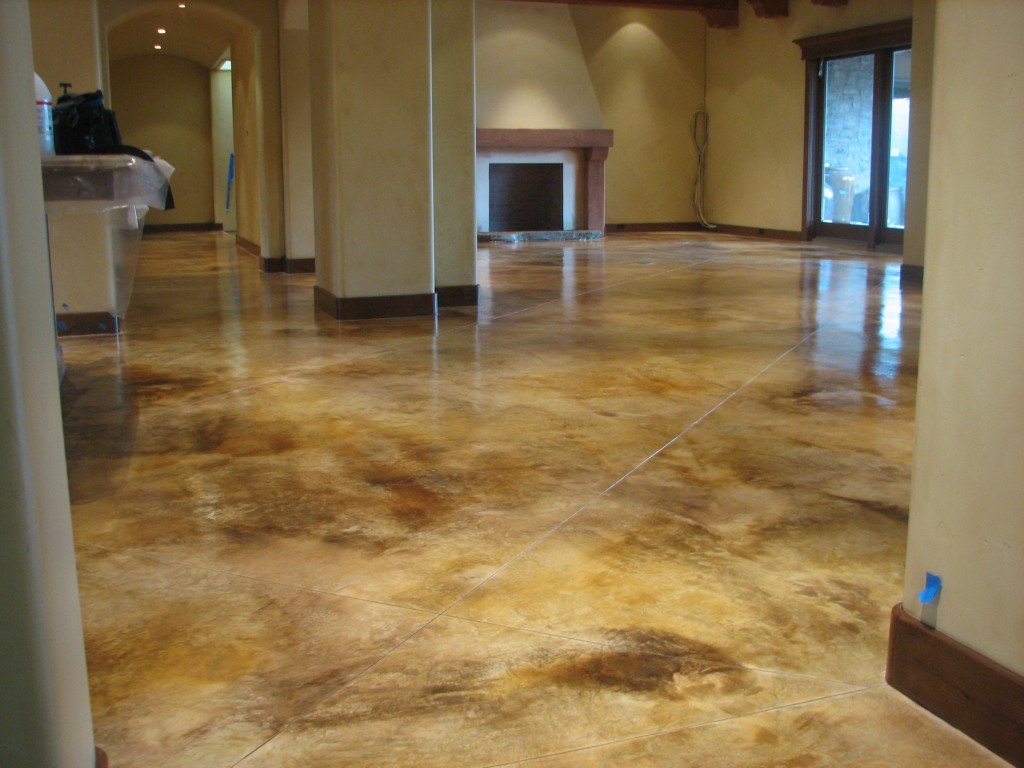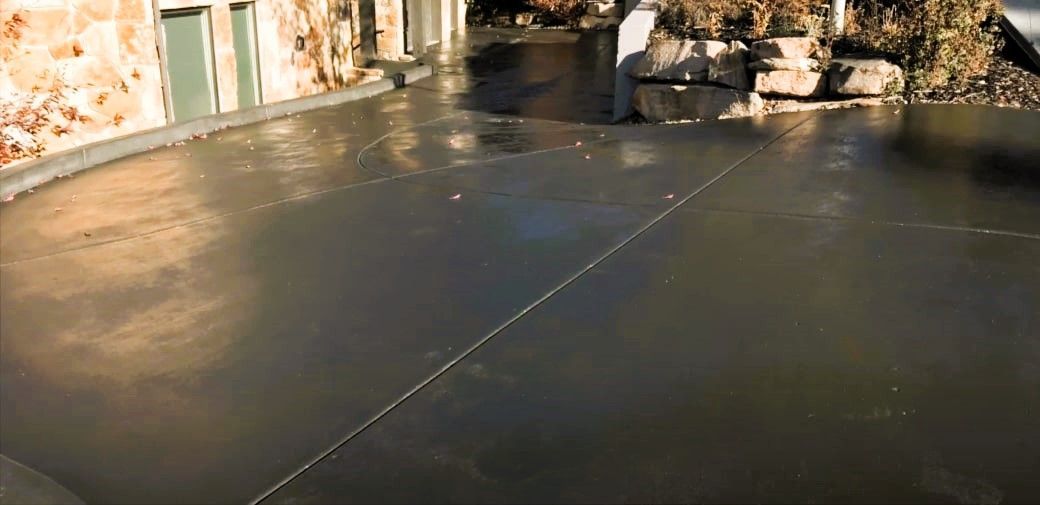Understanding the Series Of Solutions Offered in Flooring: Highlighting Stained Concrete Techniques
Stained concrete has arised as a compelling flooring option for numerous areas. Its flexibility depends on the selection between acid and water-based spots, each offering distinctive aesthetic appeals. Correct preparation and recurring maintenance are vital to guarantee its toughness and appearance. As the demand for cutting-edge flooring solutions grows, understanding the subtleties of tarnished concrete methods could open new possibilities for both domestic and business settings. What special benefits might this flooring choice offer a project?
The Fundamentals of Stained Concrete
Stained concrete serves as a versatile floor covering option that combines sturdiness with aesthetic charm. This flooring method involves applying a specially created stain to the concrete surface area, which penetrates and alters the shade of the material. The process not only boosts the visual aspects of concrete yet additionally provides the benefit of shielding it from damage. Stained concrete can achieve a variety of looks, from earthy tones to vivid shades, making it appropriate for different design motifs.
Correct prep work of the concrete surface area is necessary for suitable results. This might include cleaning, grinding, or engraving to assure the stain adheres properly. Additionally, the application process usually entails utilizing devices such as sprayers or brushes to attain uniform protection. After staining, a sealant is usually put on boost resilience and preserve the vibrancy of the shade. Ultimately, stained concrete supplies an attractive and long-lasting flooring solution for property and business spaces alike.
Sorts of Stains: Acid vs. Water-Based

On the other hand, water-based discolorations use a larger series of colors and are easier to use. They do not react chemically with concrete yet instead supply a surface area color - austin stained concrete service. Water-based stains are low in unstable organic substances (VOCs), making them more eco-friendly and appropriate for interior jobs. While they may not give the exact same depth of color as acid stains, their convenience and convenience of use make them appealing for numerous applications. Eventually, the option depends on the job's needs, desired looks, and location
Methods for Staining Concrete
The strategies for discoloring concrete differ significantly between acid and water-based techniques. Acid staining includes a chain reaction that develops special, variegated shades, while water-based discolorations supply a more comprehensive scheme and less complicated application. Understanding these procedures is necessary for accomplishing the preferred visual in concrete flooring.
Acid Staining Refine
Acid staining uses a vibrant means to boost the visual appeal of concrete surface areas. This procedure entails applying a mix of water, hydrochloric acid, and pigments to the concrete, which reacts chemically to generate vivid, clear shades. First, the concrete surface needs to be extensively cleansed and prepped to ensure suitable attachment. Once applied, the acid stain permeates the concrete, creating one-of-a-kind marbled impacts as it responds with the lime in the concrete. After the desired shade develops, the surface area is counteracted and rinsed to stop the reaction. Lastly, a sealant is put on protect the surface and boost toughness. Acid staining not just transforms the look of concrete yet also gives a lasting option for decorative floor covering.
Water-Based Staining Advantages
Just how can water-based staining elevate the visual and useful qualities of concrete surface areas? Water-based stains use a functional remedy for enhancing concrete, giving vivid color choices while assuring environmental safety and security. Unlike acid spots, water-based choices pass through the surface area, enabling even color circulation and a range of surfaces, from matte to shiny. Additionally, they are low in unpredictable natural substances (VOCs), making them less harmful to indoor air high quality. Their fast drying out time helps with quicker task completion, while their resistance to fading makes sure lasting elegance. Water-based discolorations can also enhance the concrete's sturdiness and resistance to stains, making them an excellent option for both household and commercial applications. Ultimately, they give a sustainable, appealing remedy for numerous concrete surface areas.
Style Opportunities With Stained Concrete
Stained concrete deals a range of style possibilities that can improve any space. Techniques such as shade variant, different surface area ending up choices, and custom-made style patterns enable for special and individualized floor covering services. These components not just elevate looks yet additionally add to the general performance of the concrete surface area.
Color Variant Techniques
While exploring the layout opportunities of discolored concrete, color variant strategies play a pivotal role in enhancing both visual allure and performance. These methods permit the creation of special patterns and impacts that can transform a basic concrete surface into an aesthetically striking component of a room. Options such as acid staining, which responds chemically with the concrete, create rich, transparent colors that simulate natural rock. Water-based spots provide a wider shade palette and enable more control in style. Layering various spots can produce depth and measurement, giving a tailored appearance. By integrating shade variation methods, designers can attain diverse designs, from rustic to contemporary, making certain that discolored concrete fits perfectly right into any kind of layout plan.
Surface Area Finishing Options
The exploration of shade variant strategies sets the stage for taking into consideration surface ending up choices, which substantially impact the general appearance and functionality of discolored concrete. Numerous finishes can improve the aesthetic appeal and longevity of the surface. Typical choices include matte, satin, and shiny finishes, each offering an unique aesthetic impact. Matte coatings offer a subtle, downplayed style, while satin finishes strike an equilibrium between sheen and functionality, making them prominent for residential and commercial spaces. Glossy surfaces, on the various other hand, create a high-shine appearance, boosting shade vibrancy and light representation. Furthermore, surface area therapies such as sprucing up or securing further improve longevity, making these finishing options crucial considerations in developing functional and visually enticing stained concrete floorings.
Customized Layout Patterns
How can customized design patterns elevate the allure of stained concrete? By integrating special styles, stained concrete can transform ordinary floor covering right into a striking aesthetic statement. Customized patterns, such as geometric shapes, intricate motifs, or natural styles, enable personalization, making spaces feel customized and inviting. Clients can choose from a variety of strategies, including saw cuts, stencils, or overlays, to attain wanted results. Furthermore, combining numerous colors with numerous stain strategies boosts the deepness and dimension of the patterns. These style opportunities not only boost aesthetic allure yet also raise the value of residential or industrial spaces. Inevitably, custom-made design patterns give a chance for imagination, establishing discolored concrete apart from standard floor covering choices.
Preparing Your Concrete Surface Area
Proper prep work of the concrete surface area is important for achieving a successful tarnished finish. This process begins with thorough cleansing to eliminate dust, grease, and any various other pollutants. A stress washing machine or a floor scrubber can properly eliminate these compounds, guaranteeing a fresh start for staining. After cleaning, it is crucial to fix any splits or flaws in the concrete. This can be completed using a concrete patching compound, which must be allowed to treat totally prior to proceeding.
Once the surface area is clean and repaired, grinding or sanding may be essential to create a smooth, even appearance. This step enhances the concrete's capability to soak up the stain evenly. A concrete etcher can be used to open up the pores of the surface area, permitting for far better attachment of the stain. By adhering more information to these prep work actions, the resulting stained concrete will exhibit a more vibrant and enduring surface
Maintenance and Look After Stained Concrete
Preserving stained concrete is important for protecting its appearance and durability after the first prep work and application of stain. Routine cleaning is essential; sweeping or vacuuming to remove dirt and debris protects against scrapes and monotony. For deeper cleansing, a moderate pH-neutral detergent blended with water can be made use of, adhered to by detailed washing to prevent residue build-up.
Sealing tarnished concrete is an additional crucial upkeep action, as it secures the surface from discolorations and moisture. Depending on the sealer type, reapplication might be necessary every one to 3 years. Furthermore, avoiding harsh chemicals and rough tools aids preserve from this source the integrity of the stain.
For exterior tarnished concrete, it is advisable to clear snow or ice without delay to avoid damage from freeze-thaw cycles. Overall, consistent treatment guarantees that tarnished concrete keeps its vibrant color and architectural stability gradually, making it a lasting flooring selection.

Expense Factors To Consider for Stained Concrete Flooring
When assessing the expense of discolored concrete floor covering, possible house owners commonly question the numerous factors that affect pricing. Key factors to consider consist of the dimension of the location to be covered, the intricacy of the layout, and the kind of stain utilized. Basic staining methods often tend to be much more inexpensive, while intricate patterns or numerous shades can greatly raise prices.

Geographic location is one more element, as prices can vary commonly from one area to an additional. Ongoing maintenance expenses should be factored in, as sealants and safety layers may be necessary over time to protect the aesthetic and sturdiness of the discolored concrete.
Often Asked Questions
Can Stained Concrete Be Applied Over Existing Floor Covering?
The question of whether tarnished concrete can be used over existing floor covering is usually asked. Normally, it is possible, offered the underlying surface is clean, secure, and appropriate for correct bond of the tarnished concrete.
For how long Does the Staining Process Take?
The staining procedure commonly takes a few hours to a complete day, depending upon the dimension of the location and the complexity of the style. Curing might need additional time before the surface area is fully functional.
Is Stained Concrete Suitable for Outdoor Usage?
Stained concrete is certainly suitable for outdoor use, as it holds up against numerous weather. Its durability and aesthetic charm make it a preferred selection for patios, pathways, and driveways, improving both capability and aesthetic passion.
Can I Adjustment the Shade of Stained Concrete Later On?
The ability to change the color of Web Site stained concrete later on depends upon different variables, consisting of the initial stain type and surface area prep work. Consulting a specialist can give advice on prospective alternatives and end results for shade change.
Exist Eco-Friendly Options for Stained Concrete?
The query concerning eco-friendly options for stained concrete reveals an expanding rate of interest in lasting structure methods. Lots of business currently offer low-VOC stains and environmentally pleasant sealers, guaranteeing aesthetic allure while minimizing environmental impact.